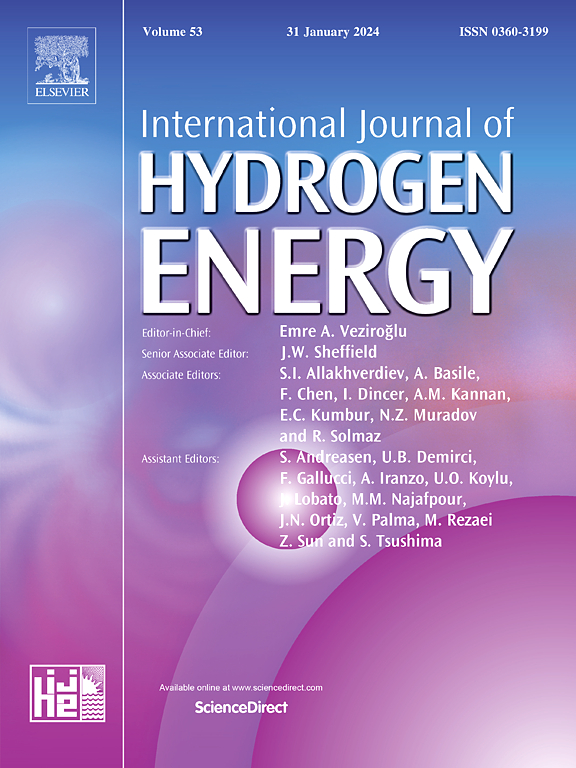A quantitative risk assessment method for hydrogen fuel cell vehicles in residential garages
IF 8.1
2区 工程技术
Q1 CHEMISTRY, PHYSICAL
引用次数: 0
Abstract
Since hydrogen fuel cell vehicle (HFCV) has zero emission and no pollution, it is one of main development directions of new energy vehicles in the future. Parking time of the vehicle in the garage far exceeds the driving time. The ventilation in residential garage is insufficient and therefore the leaked hydrogen is more likely to be accumulated. Jet fire and explosion bring serious casualties and property losses. It may also cause oxygen concentration reduction leading to hypoxia asphyxiation in the residential garage scenario. A quantitative risk assessment method based on Hydrogen Plus Other Alternative Fuels Risk Assessment Models (HyRAM+) assessment framework and Latin Hypercube sampling (LHS) method is proposed. The uncertainty of hydrogen leak frequency, leak detected and isolated probability, ignition probability and asphyxiation probability are fully quantified. The randomness of occupant locations is considered by LHS method. Risk metrics are calculated to measure the severity of accidents, and whether the risk is within the acceptable risk range is judged. The assessment results show that the risk contribution rate of jet fire is significantly higher than that of explosion and asphyxiation. Average individual risk at each pressure and HFCV is far below 10−5 in current case, which is within the acceptable risk level of the staff. The most effective factors for reducing system unreliability and the main sources of risk are identified.
住宅车库氢燃料电池汽车风险定量评估方法
氢燃料电池汽车具有零排放、无污染的特点,是未来新能源汽车的主要发展方向之一。车辆在车库里停放的时间远远超过行驶的时间。住宅车库通风不足,泄漏的氢气更容易积聚。射流火灾和爆炸造成严重的人员伤亡和财产损失。它还可能导致氧浓度降低,导致住宅车库场景中的缺氧窒息。提出了一种基于氢和其他替代燃料风险评估模型(HyRAM+)评估框架和拉丁超立方抽样(LHS)方法的定量风险评估方法。对氢气泄漏频率、检漏隔离概率、着火概率和窒息概率的不确定性进行了充分量化。利用LHS方法考虑了占用者位置的随机性。计算风险度量来衡量事故的严重程度,并判断风险是否在可接受的风险范围内。评价结果表明,射流火灾的风险贡献率显著高于爆炸和窒息的风险贡献率。目前病例中每个压力和HFCV的平均个体风险远低于10 - 5,在工作人员可接受的风险水平范围内。确定了降低系统不可靠性的最有效因素和主要风险来源。
本文章由计算机程序翻译,如有差异,请以英文原文为准。
求助全文
约1分钟内获得全文
求助全文
来源期刊

International Journal of Hydrogen Energy
工程技术-环境科学
CiteScore
13.50
自引率
25.00%
发文量
3502
审稿时长
60 days
期刊介绍:
The objective of the International Journal of Hydrogen Energy is to facilitate the exchange of new ideas, technological advancements, and research findings in the field of Hydrogen Energy among scientists and engineers worldwide. This journal showcases original research, both analytical and experimental, covering various aspects of Hydrogen Energy. These include production, storage, transmission, utilization, enabling technologies, environmental impact, economic considerations, and global perspectives on hydrogen and its carriers such as NH3, CH4, alcohols, etc.
The utilization aspect encompasses various methods such as thermochemical (combustion), photochemical, electrochemical (fuel cells), and nuclear conversion of hydrogen, hydrogen isotopes, and hydrogen carriers into thermal, mechanical, and electrical energies. The applications of these energies can be found in transportation (including aerospace), industrial, commercial, and residential sectors.
 求助内容:
求助内容: 应助结果提醒方式:
应助结果提醒方式:


